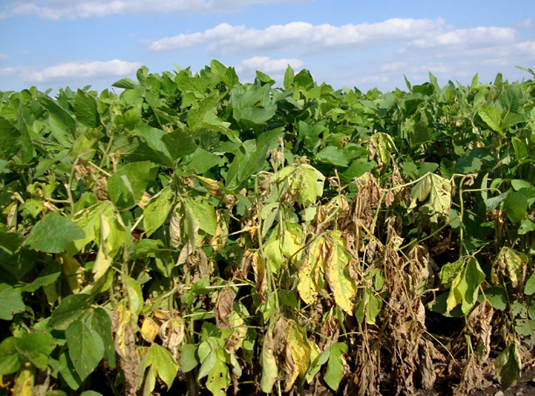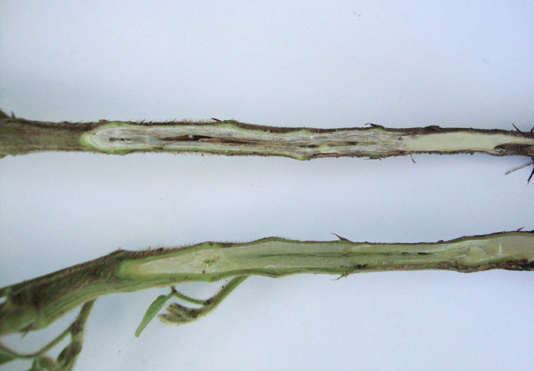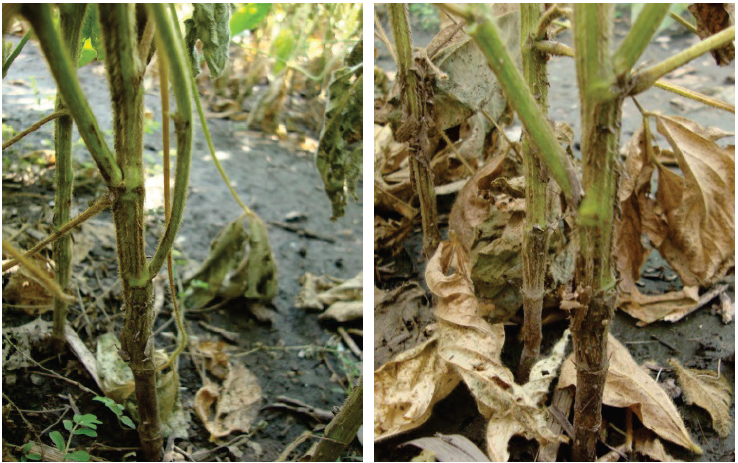Disease Facts
- Caused by the soil-borne fungus Phytophthora sojae (also known as Phytophthora megasperma f. sp. glycinea).
- Pathogen has many races, and multiple races occur in each field.
- Disease is favored by extended wet field conditions.
- May attack soybeans at any time during the growing season.
- Displays seed rot, seedling blight and root/stem rot phases.
- Above-ground symptoms may not be evident for several weeks after initial infection.

Figure 1. Soybean plants wilting due to Phytophthora.
Conditions Favoring Disease Development
- Associated with wet soil conditions.
- Commonly occurs on heavy, poorly drained or compacted soils.
- May occur on any soil saturated for an extended
period of time.
- The ideal temperature for infection is 60 to 80º F (15 to 27º C).
- Successive years of soybeans on the same fields may increase damage potential.
- Application of high levels of potash, manure or municipal sludge immediately before planting may increase disease severity.
Disease Cycle
- Disease-causing fungus is a water mold, or Oomycete, characterized by oospores and zoospores.
- Oospores act as survival mechanism of the fungus.
- May persist in soybean residue and soil for years.
- Zoospores are produced when oospores germinate in the presence of a soybean crop.
- Zoospores also produced from infected soybean tissue during the growing season.
- Swim through films of water to the root.
- Fungus infects root and grows into and among the root cells of the plant.
- Disease survives in soybean residue and in the soil.

Figure 2. Wilted plants surrounded by healthy plants is often a symptom of Phytophthora.
Impact on Crop
- The Phytophthora fungus can kill plants at all stages of growth.
- Stand reduction may result in replanting or yield loss.
- Replanting is common when early infection results in
severe seed rot and damping off of seedlings.
- In some cases, infected stands survive but are less productive than healthy stands.
- Yield reductions can range from as little as 5% to more than 50% depending on severity.
Phytophthora Symptoms
- Seed Rot Phase – may begin at imbibition.
- Infected seeds become dark brown and soft to mushy.
- Complete deterioration of the seed may occur.
- Seedling Blight Phase – occurs at emergence or soon after.
- “Damping off” – rapid decay, wilting and plant death.
- Symptoms include a dark brown to black discoloration of the stem, usually beginning at the soil line.
- Diseased tissues quickly become soft and water-soaked, and wilting and plant death may soon follow.
- Root and Stem Rot Phase – symptoms begin in the root.
- Brown, discolored taproot and secondary roots and less root mass.
- Nodulation is often minimal, leading to chlorotic, N-deficient plants.
- Affected plants may be stunted, so fields have an uneven appearance.
- Root and Stem Rot Phase – symptoms may spread to the stem.
- Brown discoloration develops at the soil line.
- Dark-brown to red-brown lesion may progress up the stem (key diagnostic feature of the stem rot phase).
- Diseased tissues quickly become soft and water-soaked, and wilting and plant death may soon follow, especially during stress periods.

Figure 3. Split stem shows brown discoloration due to Phytophthora infection (top). Healthy stem (bottom).

Figure 4. Note dark-brown extending upward from the soil line
Management
- Variety Selection and Seed Treatments – most effective means of managing Phytophthora.
- Corteva Agriscience researchers are developing varieties with resistance genes and field tolerance to Phytophthora.
- Corteva Agriscience uses molecular breeding to develop varieties with race-specific resistance genes such as Rps 1C, Rps 1K, and Rps 3a.
- Race-specific resistance provides complete resistance to specific races throughout the growing season.
- Field tolerance provides partial protection against all races of Phytophthora.
- Field tolerance is not as effective in the seed and
seedling growth stages but provides benefit in-season.
- Varieties containing race-specific resistance and favorable field tolerance coupled with Lumisena™ fungicide seed treatment is the ideal combination because they provide multiple mechanisms to protect against Phytophthora.
- Pioneer® brand soybean varieties are rated for tolerance and these ratings are provided to customers – ratings range from 2-9 (9=tolerant) with a majority of varieties scoring between 4 and 6.
- Field Drainage and Soil Structure – improve field drainage and remediate compaction and hardpan layers if possible.
- Planting Date – on heavy soils or in no-till systems, early planting may not be an option.
The foregoing is provided for informational use only. Please contact your Pioneer sales professional for information and suggestions specific to your operation. Product performance is variable and depends on many factors such as moisture and heat stress, soil type, management practices and environmental stress as well as disease and pest pressures. Individual results may vary. Components of LumiGEN™ technologies for soybeans are applied at a Corteva Agriscience production facility, or by an independent sales representative of Corteva Agriscience or its affiliates. Not all sales representatives offer treatment services, and costs and other charges may vary. See your sales representative for details. Seed applied technologies exclusive to Corteva Agriscience and its affiliates. Pioneer® brand products are provided subject to the terms and conditions of purchase which are part of the labeling and purchase documents. CF180524 (200707)











